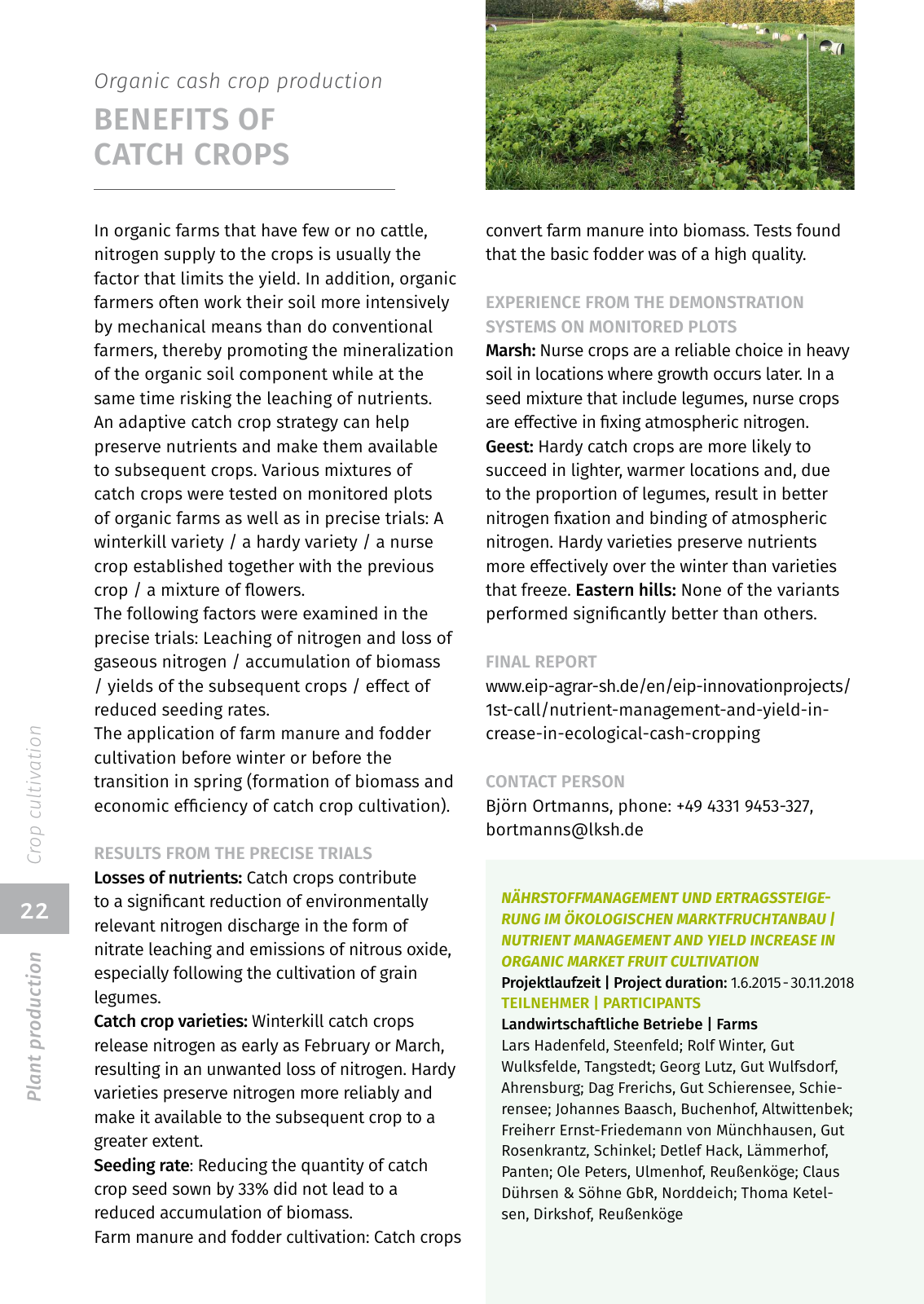In organic farms that have few or no cattle nitrogen supply to the crops is usually the factor that limits the yield In addition organic farmers often work their soil more intensively by mechanical means than do conventional farmers thereby promoting the mineralization of the organic soil component while at the same time risking the leaching of nutrients An adaptive catch crop strategy can help preserve nutrients and make them available to subsequent crops Various mixtures of catch crops were tested on monitored plots of organic farms as well as in precise trials A winterkill variety a hardy variety a nurse crop established together with the previous crop a mixture of flowers The following factors were examined in the precise trials Leaching of nitrogen and loss of gaseous nitrogen accumulation of biomass yields of the subsequent crops effect of reduced seeding rates The application of farm manure and fodder cultivation before winter or before the transition in spring formation of biomass and economic efficiency of catch crop cultivation RESULTS FROM THE PRECISE TRIALS Losses of nutrients Catch crops contribute to a significant reduction of environmentally relevant nitrogen discharge in the form of nitrate leaching and emissions of nitrous oxide especially following the cultivation of grain legumes Catch crop varieties Winterkill catch crops release nitrogen as early as February or March resulting in an unwanted loss of nitrogen Hardy varieties preserve nitrogen more reliably and make it available to the subsequent crop to a greater extent Seeding rate Reducing the quantity of catch crop seed sown by 33 did not lead to a reduced accumulation of biomass Farm manure and fodder cultivation Catch crops convert farm manure into biomass Tests found that the basic fodder was of a high quality EXPERIENCE FROM THE DEMONSTRATION SYSTEMS ON MONITORED PLOTS Marsh Nurse crops are a reliable choice in heavy soil in locations where growth occurs later In a seed mixture that include legumes nurse crops are effective in fixing atmospheric nitrogen Geest Hardy catch crops are more likely to succeed in lighter warmer locations and due to the proportion of legumes result in better nitrogen fixation and binding of atmospheric nitrogen Hardy varieties preserve nutrients more effectively over the winter than varieties that freeze Eastern hills None of the variants performed significantly better than others FINAL REPORT www eip agrar sh de en eip innovationprojects 1st call nutrient management and yield in crease in ecological cash cropping CONTACT PERSON Björn Ortmanns phone 49 4331 9453 327 bortmanns lksh de NÄHRSTOFFMANAGEMENT UND ERTRAGSSTEIGE RUNG IM ÖKOLOGISCHEN MARKTFRUCHTANBAU NUTRIENT MANAGEMENT AND YIELD INCREASE IN ORGANIC MARKET FRUIT CULTIVATION Projektlaufzeit Project duration 1 6 2015 30 11 2018 TEILNEHMER PARTICIPANTS Landwirtschaftliche Betriebe Farms Lars Hadenfeld Steenfeld Rolf Winter Gut Wulksfelde Tangstedt Georg Lutz Gut Wulfsdorf Ahrensburg Dag Frerichs Gut Schierensee Schie rensee Johannes Baasch Buchenhof Altwittenbek Freiherr Ernst Friedemann von Münchhausen Gut Rosenkrantz Schinkel Detlef Hack Lämmerhof Panten Ole Peters Ulmenhof Reußenköge Claus Dührsen Söhne GbR Norddeich Thoma Ketel sen Dirkshof Reußenköge BENEFITS OF CATCH CROPS Organic cash crop production 22 Pl an t pr od uc ti on Cr op c ul ti va ti on

Hinweis: Dies ist eine maschinenlesbare No-Flash Ansicht.
Klicken Sie hier um zur Online-Version zu gelangen.
Klicken Sie hier um zur Online-Version zu gelangen.